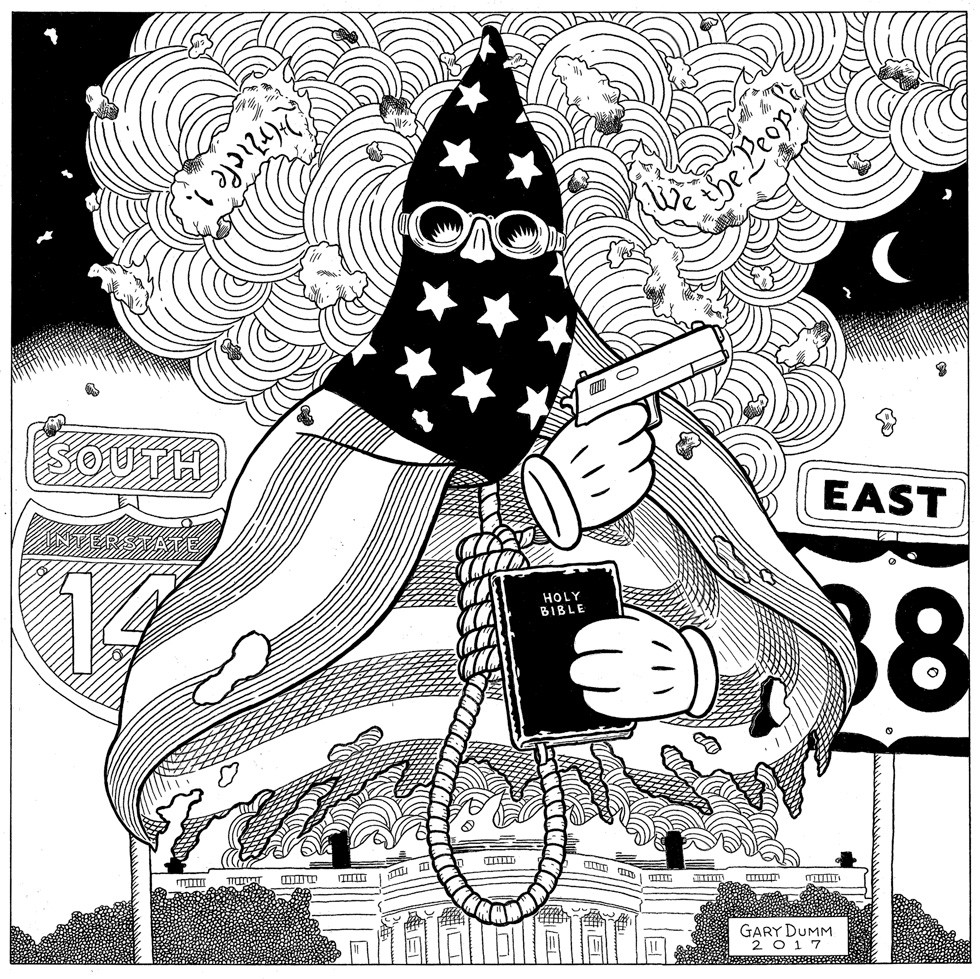Dissent is as old as human society. One can argue that Jesus Christ was a dissident intellectual who condemned the abuse of moral values, those values being equality and love for one's neighbor. Dissent is what keeps us from becoming robots. It's speaking out to your coworker about his or her racist political rants. It's voicing your disagreement with the slack-jawed dude at the bar, despite a possible beat down.
The Episcopal Church broke away from the Church of England in dissent against the monarchy, and Episcopalians have been supporting civil rights, gay marriage and full legal equality for all people for a long time. That the Shaker Community Gallery and its latest exhibition, The Art of Dissent, are housed inside Christ Episcopal Church seems fitting. This second show at the SCG has four artists' work on exhibit in the small rectory: Michaelangelo Lovelace, Liz Maugans and Laura and Gary Dumm.
Walking into the chapel, we are faced with a piece titled "The Deportation Wall," by Lovelace. He is known for paintings based on the struggles of poverty and urban life and for balancing love and community through his own experiences. Here, and in many pieces, he has us questioning our American values.
In this powerful painting of hard bricks and human eyes, we reflect on those values of freedom and justice for all, not just a few. Lovelace created this artwork in response to the president's announcement about building the 30-foot border wall. Walls equal division, not protection, and here we are not only being observed by immigrant eyes, we are being observed by the world and peering back at ourselves.
In his smaller paintings, Lovelace takes us into the streets of the city, on a journey of realities. In the lower left painting we find ourselves standing at the intersection of Joy and Pain. On one street we can walk through the bright doorway into the community development center, or we can enter the gruesome abyss of the unemployment office. Both venues are packed. In the lower right painting we can cross the street into God's House or into the bar; the choice is ours to make. What will the moral of your story be?
Maugans created her Apathy Parade series when the 2016 presidential campaign was in full swing. In these prints, Maugans has removed the original banner messages and replaced them with rants and debates pulled from social media. One very effective piece describes the complacency of the status quo. "It's a disease. Nobody thinks or feels or cares anymore; nobody gets excited or believes in anything except their own comfortable little God damn mediocrity." Maugans is one of Cleveland's strongest arts advocates as well as a civic and political lobbyist. Her work shows us that research better equips us to be agents for social change. To that end, Maugans has created small prints where visitors can write their own slogans on banners held up by two personages and post them in the gallery.
Laura and Gary Dumm have created three large-scale paintings in their environmental pop-surrealist series. Using iconic movie monsters, the Dumms have presented a poignant opinion on pollution, climate change and engineering. Maria, the android from Metropolis, poses as the god Shiva. With her ominous stare piercing right through us, she grips a commentary on pop culture in each of her manmade hands, from Marilyn Monroe and fast food to reality television and industry. Moving to the center painting, we find Audrey Jr., the plant from Little Shop of Horrors, as Monsanto, killing off bees and trapping them in its gaping maw. The final painting depicts the great Gorgon, Medusa. Behind her we find an octopus bearing down on the Beatles' yellow submarine while Nemo watches helplessly as the disembodied head turns the bright coral reefs to stone.
The last piece to enter the show is a pen and ink drawing by Gary Dumm. The drawing, titled "The Invisible Man Returns to Fascism," is a direct response to the horrific events in Charlottesville. Here the Invisible Man floats between Interstate 14 and Rt. 88, above the Capital building, shrouded in a burning American flag; the stars form a clansman's hood as he holds a gun in one hand and a bible in the other. A noose hangs like a pendant from his neck. Above this figure we find the epic words, "We the People..." and "Article 1" belched away in a puff of smoke, much like the separation of powers in our government.


